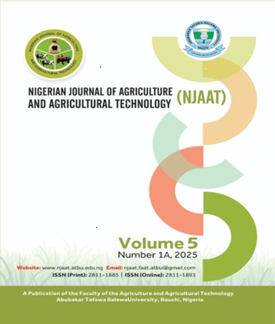EFFECT OF STORAGE CONDITIONS ON THE QUALITY OF TIGER NUT OIL
DOI:
https://doi.org/10.59331/njaat.v5i1A.981Keywords:
Quality, Storage, Conditions, Tiger nut, Oil, Shelf-lifeAbstract
The study investigated the effect of storage conditions on the physio-chemical properties of tiger nut oil, a product known for its nutritional and medicinal benefits. Tiger nut oil was extracted using a mechanical expeller and stored under three conditions: room temperature (28°C), refrigeration (4°C), and freezing (-18°C) for two months. Key parameters analyzed before and after storage included moisture content, iodine value, saponification value, free fatty acid content, and percentage impurity. It was revealed that storage temperature had no significant impact on the oil's quality attributes at (p≤0.05). Moisture content remained stable,,ranging from 2.27% to 2.29%. The highest moisture content was observed under freezing condition (2.29%), while the lowest was at room temperature (2.28%), with minimal variation under different temperatures. Percentage impurities ranged from 0.83% to 1.00% and iodine value ranging from 31.69 g I/100g to 31.90 g I/100g, also displayed no significant changes, confirming the oil’s resistance to contamination and oxidation. Saponification values varied from 186.313 to 189.643 mg KOH/g without significant impact from either factor; While a slight increase in free fatty acid content was observed at room temperature (4.98%), the values remained within acceptable limits, indicating the oil's resistance to hydrolytic degradation. Tiger nut oil exhibits remarkable stability across various storage conditions, making it suitable for storage under ambient, refrigerated, or frozen environments without compromising quality.
Downloads
Downloads
Published
How to Cite
Issue
Section
License
Copyright (c) 2025 Nigerian Journal of Agriculture and Agricultural Technology

This work is licensed under a Creative Commons Attribution-NonCommercial-ShareAlike 4.0 International License.
This work is licensed under a CC Attribution-NonCommercial-ShareAlike 4.0







